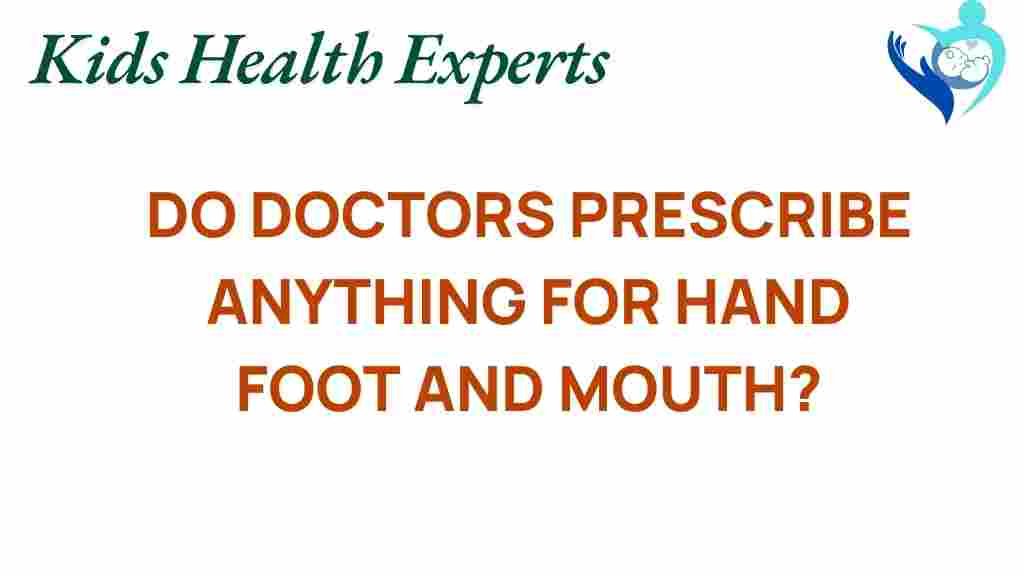Do Doctors Really Prescribe Treatments for Hand, Foot, and Mouth Disease?
Hand, Foot, and Mouth Disease (HFMD) is a common viral infection that primarily affects children under the age of five. Characterized by fever, mouth sores, and a rash on the hands and feet, this illness can cause considerable discomfort for young patients. As a parent or caregiver, understanding the treatment options available and knowing when to consult with a doctor can make a significant difference in managing your child’s symptoms and ensuring their recovery. In this article, we will explore whether doctors prescribe treatments for Hand, Foot, and Mouth Disease, delve into its symptoms, discuss recovery options, and provide useful healthcare advice.
Understanding Hand, Foot, and Mouth Disease
Hand, Foot, and Mouth Disease is caused by enteroviruses, most commonly the Coxsackievirus. It spreads easily through direct contact with infected individuals or contaminated surfaces, making it especially prevalent in daycare settings. The symptoms typically appear three to seven days after exposure and may include:
- Fever
- Sore throat
- Painful mouth sores
- Rash on the hands and feet
- Loss of appetite
- General malaise
Diagnosing Hand, Foot, and Mouth Disease
When a child presents symptoms of Hand, Foot, and Mouth Disease, a visit to the doctor is essential for an accurate diagnosis. During the examination, a healthcare provider will typically:
- Assess the child’s medical history
- Perform a physical examination, checking for characteristic sores and rashes
- Rule out other illnesses with similar symptoms, such as chickenpox or herpes simplex virus
Once diagnosed, parents often wonder about the treatment options available and whether doctors will prescribe medication.
Do Doctors Prescribe Treatments for Hand, Foot, and Mouth Disease?
In most cases, Hand, Foot, and Mouth Disease is mild and self-limiting, meaning it typically resolves on its own without the need for prescription medications. Doctors usually focus on managing the symptoms to ensure the child is comfortable during the recovery process.
Symptomatic Treatment Options
While there is no specific antiviral treatment for HFMD, doctors may recommend various supportive care strategies, including:
- Over-the-counter pain relievers: Medications such as acetaminophen (Tylenol) or ibuprofen (Advil) can help alleviate fever and pain.
- Topical oral anesthetics: Products containing benzocaine can soothe painful mouth sores, making it easier for children to eat and drink.
- Hydration: Encouraging fluid intake is crucial, especially since mouth sores can make drinking uncomfortable. Ice pops and cold liquids may be more palatable.
- Soft foods: Offering soft, bland foods can help ease discomfort during meals.
When to Consider Prescription Medications
In rare cases, if a child develops severe symptoms or complications, a doctor may prescribe medications. This is not common for typical HFMD cases, but potential scenarios include:
- Persistent high fever that does not respond to over-the-counter medications
- Severe dehydration due to inability to drink fluids
- Secondary bacterial infections
If any of these situations arise, it’s imperative to seek medical attention promptly.
Recovery from Hand, Foot, and Mouth Disease
The recovery timeline for Hand, Foot, and Mouth Disease can vary. Most children begin to feel better within a week to ten days. Here are some general recovery guidelines:
- Rest: Ensure the child gets plenty of rest to help their immune system fight off the virus.
- Monitor symptoms: Keep an eye on fever and pain levels and administer medications as necessary.
- Encourage hydration: Offer fluids regularly to prevent dehydration.
- Consult a doctor: If symptoms worsen or new symptoms arise, reach out to a healthcare professional.
Preventing Hand, Foot, and Mouth Disease
While it may not be possible to completely prevent Hand, Foot, and Mouth Disease, especially in communal settings like daycare, there are several steps you can take to reduce the risk:
- Practice good hygiene: Encourage regular handwashing with soap and water, especially after using the bathroom and before meals.
- Disinfect surfaces: Regularly clean toys and surfaces that children frequently touch.
- Avoid close contact: Keep infected children at home until they are no longer contagious, typically after fever resolves and sores have healed.
Troubleshooting Tips for Parents
Dealing with Hand, Foot, and Mouth Disease can be challenging for parents. Here are some troubleshooting tips to help you navigate the situation:
- Stay calm: Understanding that HFMD is usually mild can help you manage your anxiety.
- Communicate with caregivers: If your child is in daycare or school, inform the staff about the illness to prevent further spread.
- Keep a symptom diary: Note down your child’s symptoms, medication doses, and any changes in behavior to discuss with the doctor if needed.
- Seek support: Don’t hesitate to reach out to other parents or healthcare professionals for advice or reassurance.
Conclusion
Hand, Foot, and Mouth Disease is a common viral illness that primarily affects children. While doctors typically do not prescribe specific treatments, they can offer valuable advice on managing symptoms and ensuring a smooth recovery. Parents should focus on providing supportive care, monitoring their child’s symptoms, and maintaining good hygiene practices to prevent the spread of the virus. If complications arise or symptoms worsen, consulting a healthcare provider is essential. For more information on pediatric health issues, visit this resource. Additionally, you may find further details about Hand, Foot, and Mouth Disease on this external site. Remember, staying informed and proactive is key in managing your child’s health.
This article is in the category Conditions and created by KidsHealthExperts Team
